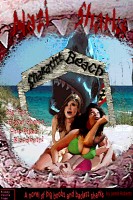Would you watch a horror movie just for one great shot? I did. Because Svengali, while not a bad film by any stretch, offers one awesome shot at its centerpiece that really makes it worthwhile. Want to know what that shot is? Keep reading.
Svengali is based on George de Maurier's Trilby, the somewhat antisemitic story of an artist's model named Trilby, who falls under the spell of amoral Jewish hypnotist Svengali. Svengali himself is a stereotype, not unlike Shylock. He has the long nose, dark eyes, beard, and a generally avaricious nature. The great John Barrymore himself portrays Svengali in the film. You'd think that would ensure great depth in the character, but no, the character remains a little flat, though still fascinating.
This fascination with Svengali is what the film is shooting for, because the film's title is not Trilby, but Svengali, the supposed villain. It'd be like if Dark Knight were called Joker--it changes everything. Dracula was always called Dracula, but this required a creative choice. One would expect this change in title would result in a more sympathetic approach to Svengali, but not so. He is a repugnant character. Initially he's played for laughs and I actually found him kind of funny; I would have been willing to sympathize. But it quickly turns sinister. Kind of like Dickens' Uriah Heep, everything Svengali does or says is self-serving. He has British 'friends,' but it's clear he only visits them to mooch. He teaches piano, but clearly just to seduce women. He seduces women just to make money off them. There is no better side of him to appeal to; being nice to him doesn't help. He can seem very kind, but he really cares not the slightest for anyone else's well-being. And he's ever playing the victim. The final moment of the film is a grim apotheosis of this personality. Having acquired nearly everything he ever wanted, he calls out to God to grant him in heaven what was deprived of him in life and smiles, seemingly assured he'll get it.
The film's plot plays out just as in the novel. Svengali discovers his eyes have hypnotic power. He himself seems convinced it's supernatural. He crosses paths with the beautiful Trilby. He's interested in her for the money he can make off her voice, although he's also keen on making her Mrs. Svengali. Once he's hypnotized her, we get the shot: Beginning with a close-up of Svengali's glowing eyes, we pan out of his apartment window out of which he's staring and hover above the city; then the camrea turns around and flies over the city to Trilby's apartment where she suddenly awakes from sleeping. I believe this was supposed to be one shot, but the trick edits were anything but smooth; it's actually about three shots. From there on, Trilby fakes her death and her artist friends eventually discover she's become Mrs. Svengali. They try to rescue her. Can they break the spell?
The art direction and cinematography each got an academy award nomination and are definitely the film's greatest achievements. The idea of a pan across the city is used in another evil hypnotist film just a year later: The Mummy. The sets are all slightly toned-down expressionism and have the feel of a Universal picture. Unfortunately the story is paced somewhat poorly and the characters don't have much time to develop, not even Svengali or Trilby. None of them are terribly likable, either. So is it worth tracking down? Not really. But if you catch it on Turner Classic Movies, watch to the middle to see that shot.
Help make this site more interesting through discussion:
Svengali (1931)
Author: Jared Roberts
Subscribe to:
Post Comments (Atom)

0 comments:
Post a Comment